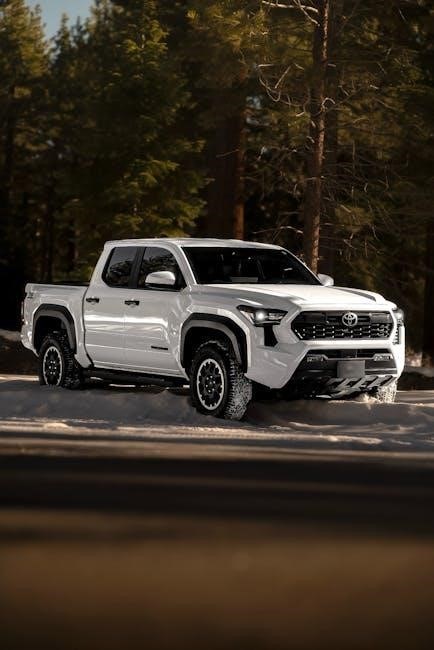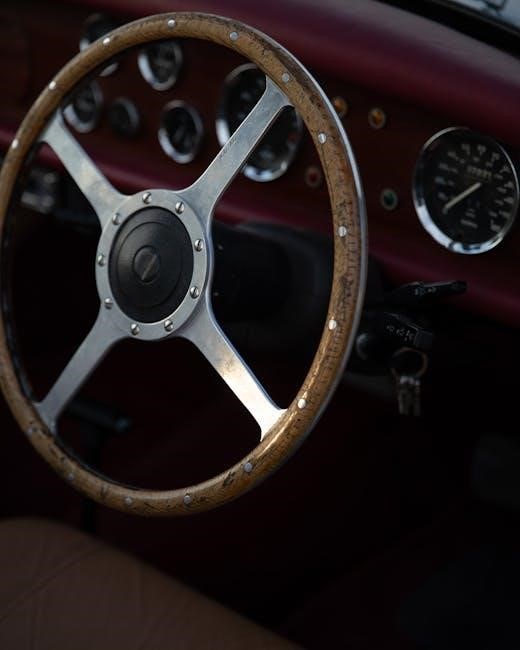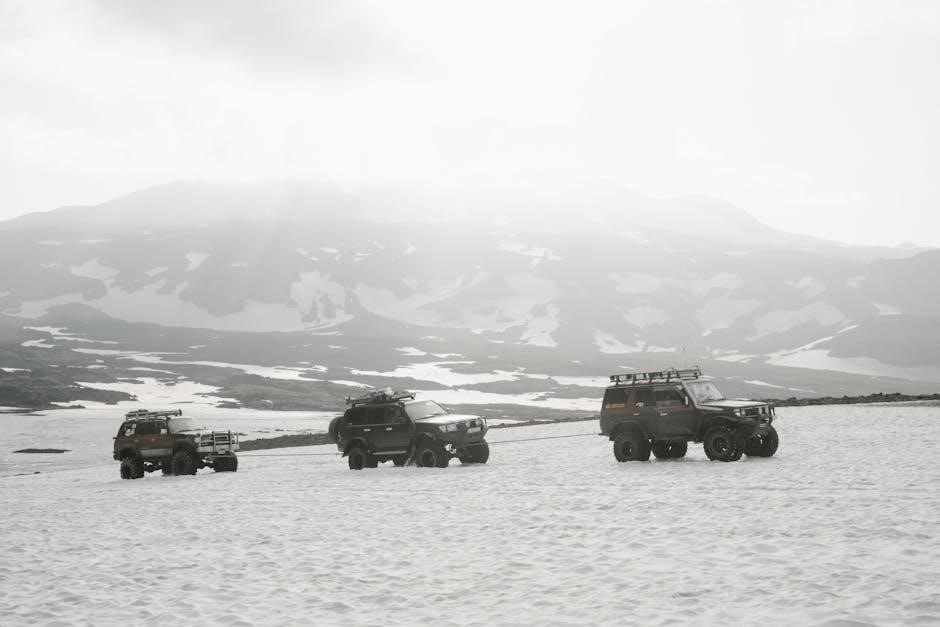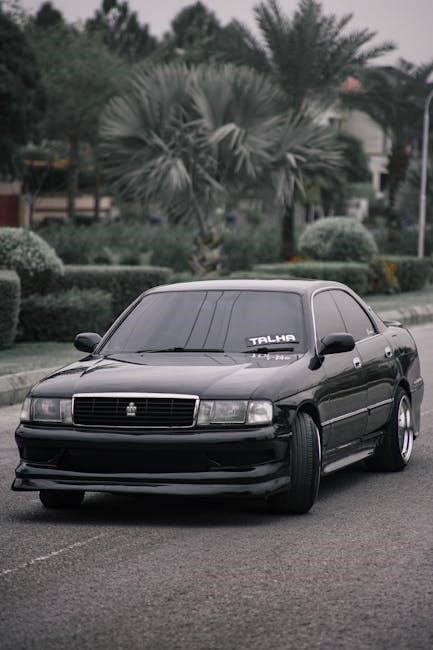
toyota four runner manual transmission
The Toyota 4Runner is a legendary SUV celebrated for its off-road prowess and durability. The availability of a manual transmission in earlier models added to its allure, offering enthusiasts precise control and a more immersive driving experience. This article explores the history, benefits, and eventual discontinuation of the manual transmission in the 4Runner, highlighting its legacy among off-road enthusiasts and driving purists.
1.1 Overview of the Toyota 4Runner
The Toyota 4Runner is a mid-size SUV renowned for its body-on-frame design and exceptional off-road capabilities. Produced since 1984, it has featured various engine options, including a manual transmission in earlier generations. Known for its reliability and durability, the 4Runner has become a favorite among off-road enthusiasts, offering a blend of ruggedness and practicality that has endured through multiple model generations.
1.2 Importance of Manual Transmission for Driving Enthusiasts
Manual transmission offers driving enthusiasts a unique connection to their vehicle, providing greater control and engagement. It allows for precise gear shifts, enhancing acceleration and responsiveness; For off-road enthusiasts, a manual gearbox enables better modulation of speed and torque, making it a preferred choice for challenging terrains. Additionally, it often comes with lower costs and better fuel efficiency compared to automatics, appealing to purists and adventurers alike.

History of Manual Transmissions in the Toyota 4Runner
The Toyota 4Runner featured manual transmissions across its first three generations, from 1984 to 2002. This option catered to driving enthusiasts seeking control and connection during adventures.
2.1 First Generation (1984-1989)
The first-generation Toyota 4Runner (1984-1989) debuted with a 2;4L inline-four engine paired with a 5-speed manual transmission. In 1988, a 3.0L V6 engine was introduced, offering both manual and automatic options. This generation laid the foundation for the 4Runner’s off-road reputation, with the manual transmission providing drivers with precise control and a more engaging driving experience during its early years.
2.2 Second Generation (1990-1995)
The second-generation Toyota 4Runner (1990-1995) continued the legacy of offering a manual transmission, with a 5-speed option available for both the 2.4L and 3.0L engines. This generation saw improvements in interior comfort while maintaining its off-road capabilities. The manual transmission remained popular among enthusiasts, providing a more connected driving experience and enhancing the vehicle’s versatility in challenging terrain.
2.3 Third Generation (1996-2002)
The third-generation Toyota 4Runner (1996-2002) offered a 5-speed manual transmission paired with a 2.7L inline-4 or 3.4L V6 engine. This generation introduced improved interior amenities and enhanced off-road capabilities. The manual option remained popular among enthusiasts until its discontinuation in 2001, marking the end of an era for driver-engaged transmissions in the 4Runner lineup.
The Last Years of Manual Transmission Availability
The manual transmission in the Toyota 4Runner was phased out after the third generation (1996-2002). This decision reflected industry trends favoring automatics for convenience and efficiency.
3.1 Focus on the Third Generation (1996-2002)
The third-generation Toyota 4Runner (1996-2002) offered a 5-speed manual transmission, paired with a 3.0L V6 engine. This combination provided robust off-road capabilities and a driving experience favored by enthusiasts. However, by 2001, Toyota discontinued the manual option, marking the end of an era for this beloved feature in the 4Runner lineup.
3.2 Reasons for Discontinuation
The discontinuation of manual transmissions in the Toyota 4Runner was driven by declining demand and shifting market preferences. As automatic transmissions became more advanced, offering improved convenience and performance, consumer interest in manual options waned. Toyota’s decision to focus on automatic transmissions aligned with industry trends, prioritizing practicality and technological advancements over the niche appeal of manual gearboxes.

Benefits of Manual Transmission
Manual transmissions in the Toyota 4Runner offer enhanced fuel efficiency, greater driver control, and a more engaging driving experience, particularly appealing to off-road enthusiasts and purists.
4.1 Enhanced Driving Experience
The manual transmission in the Toyota 4Runner provides a more direct connection between driver and vehicle. Shifting gears manually allows for precise control, especially during off-road excursions, where driver input can make a significant difference in navigating challenging terrain. This tactile engagement enhances the overall driving experience, making it more immersive and rewarding for enthusiasts who value hands-on control and responsiveness.
4.2 Off-Road Capabilities
The manual transmission in the Toyota 4Runner enhances off-road performance by allowing precise control over power delivery. Drivers can better navigate challenging terrains, such as steep inclines or rocky paths, with the ability to manually select gears. This tactile engagement enables superior modulation of speed and torque, making the manual transmission a preferred choice for enthusiasts seeking maximum off-road control and responsiveness.

Drawbacks of Manual Transmission
Manual transmissions in the Toyota 4Runner, while engaging, can be inconvenient in heavy traffic and require constant driver engagement. Their appeal has declined with advancements in automatic transmissions, which offer smoother and more efficient performance, making manuals less desirable for everyday driving and potentially lowering resale value compared to automatic models.
5.1 Challenges in Modern Driving Contexts
Manual transmissions in the Toyota 4Runner face challenges in today’s driving environments. Increased traffic and urban driving scenarios make manual shifting less practical, requiring constant driver attention. This can lead to driver fatigue, especially in stop-and-go conditions. Additionally, the rise of advanced automatic transmissions offering improved efficiency and smoothness has reduced the appeal of manuals, making them less preferred for modern commuting needs and daily driving convenience.
5.2 Comparisons with Automatic Transmission
Manual transmissions in the Toyota 4Runner are often compared to automatics for practicality and performance. While manuals offer better fuel efficiency and driver engagement, automatics provide smoother acceleration and reduced driver effort, making them more appealing in modern driving contexts. Automatic transmissions also adapt better to varying terrain and traffic conditions, often outperforming manuals in convenience and ease of use for everyday driving scenarios.

Shift to Automatic Transmissions
Toyota transitioned to automatic transmissions in the 4Runner due to market trends and demand for convenience, aligning with modern driving preferences and technological advancements in automatic systems.
6.1 Toyota’s Decision and Market Trends
Toyota’s decision to discontinue manual transmissions in the 4Runner was driven by declining demand and shifting consumer preferences towards automatics. Market trends showed increasing popularity of automatic transmissions due to their convenience and ease of use in urban driving. This shift reflected broader industry movements, with many automakers prioritizing automatics to meet customer demand and improve fuel efficiency standards.
6.2 Impact on Vehicle Performance
The shift to automatic transmissions in the Toyota 4Runner enhanced convenience and simplified driving but reduced driver engagement. While automatics improved low-speed maneuverability and smooth acceleration, they diminished the tactile connection and control offered by manual transmissions, particularly for off-road enthusiasts. This change aligned with broader industry trends favoring ease of use over driver involvement, impacting both on-road comfort and off-road precision.
Impact of Discontinuation on the Market
The discontinuation of manual transmissions in the Toyota 4Runner led to a decline in sales among driving enthusiasts and off-road aficionados, as the lack of a manual option diminished its appeal, shifting market preference toward automatic-equipped competitors.
7.1 Effects on Enthusiasts and Sales
The elimination of manual transmission in the Toyota 4Runner disappointed driving purists and off-road enthusiasts, who valued the control and connection it provided. This decision led to a slight decline in sales among this niche group, as many enthusiasts sought alternative vehicles that still offered a manual option. The shift reflected broader market trends but left a void for those who cherished the hands-on driving experience.
7.2 Market Shift Towards Automatics
The automotive industry’s shift toward automatic transmissions reflects changing consumer preferences and technological advancements. Modern automatics now offer superior convenience, smooth performance, and improved fuel efficiency, making them more appealing to the masses. This trend aligns with Toyota’s decision to focus on automatic transmissions, ensuring vehicles meet the demands of a broader market prioritizing ease and comfort over manual driving experiences.
Buyers Guide for Manual 4Runners
For enthusiasts seeking a manual 4Runner, focus on models from 1984 to 2002, particularly the first and third generations. Look for the 5-speed manual in SR5 and base trims, ensuring proper maintenance and mileage checks for optimal performance and longevity.
8.1 Identifying Models with Manual Transmission
To identify a Toyota 4Runner with a manual transmission, focus on models from the first (1984-1989) and third (1996-2002) generations. These years offered a 5-speed manual option, particularly in SR5 and base trims. Check for a manual shifter and clutch pedal, and verify the transmission type through the vehicle’s VIN or documentation. Ensure the clutch and gear engagement are smooth during a test drive to confirm functionality and condition.
8.2 Considerations for Purchase
When purchasing a Toyota 4Runner with a manual transmission, consider the model year, mileage, and condition of the clutch and gearbox. Ensure the vehicle has a clean maintenance history and inspect for any signs of wear. Prioritize models from the first and third generations, as they are more likely to have a manual option. A test drive is essential to confirm smooth gear engagement and clutch operation, ensuring reliability and performance for off-road adventures.
Maintenance Tips for Manual Transmissions
Regularly check transmission fluid levels, inspect the clutch for wear, and replace filters to ensure smooth operation. Address any unusual noises promptly to prevent damage.
9.1 Care and Maintenance
Proper care for the Toyota 4Runner’s manual transmission involves regular fluid checks, clutch inspections, and timely filter replacements. Monitoring for unusual noises ensures early detection of issues. Routine maintenance prevents wear and extends lifespan, ensuring smooth gear shifts and optimal performance both on and off the road.
9.2 Common Issues and Solutions
Common issues with the Toyota 4Runner’s manual transmission include rough shifting, worn clutch, and fluid leaks. Solutions involve adjusting or replacing the clutch, checking transmission fluid levels, and inspecting for worn synchros. Regular maintenance and addressing issues early prevent major repairs, ensuring smooth operation and extending the lifespan of the manual gearbox.
Legacy in Off-Road Culture
The Toyota 4Runner’s manual transmission solidified its status as an off-road icon, offering precise control and a direct connection to the vehicle, cherished by enthusiasts for its rugged heritage.
10.1 Role in Off-Road Enthusiasm
The Toyota 4Runner’s manual transmission has become synonymous with off-road excellence, offering drivers unparalleled control and connection to the vehicle. Its durability and precision gears made it a favorite among enthusiasts, enabling mastery of challenging terrains. The manual 4Runner embodies the spirit of adventure, fostering a deep bond between driver and machine, and is celebrated as a cornerstone of off-road culture and heritage.
10.2 Community and Heritage
The Toyota 4Runner’s manual transmission has cultivated a devoted community, uniting enthusiasts who cherish its mechanical simplicity and off-road prowess. This shared passion has fostered a rich heritage, with owners proudly preserving and celebrating their manual-equipped 4Runners. The vehicle’s legacy continues to inspire, becoming a symbol of resilience and authenticity within off-road culture, transcending mere transportation to represent a lifestyle deeply rooted in adventure and tradition.
The Toyota 4Runner’s manual transmission era has left a lasting legacy, cherished by enthusiasts for its driving engagement. While automatics dominate today, the future may see revived interest in manuals, blending tradition with modern innovation to cater to evolving driver preferences and off-road demands.
11.1 Summary of the Situation
The Toyota 4Runner once offered a manual transmission, a feature cherished by driving enthusiasts, but it was discontinued after the 2002 model year. This shift reflected broader industry trends favoring automatics for convenience and performance. While modern 4Runners rely on automatic transmissions, the legacy of the manual lives on among off-road enthusiasts who value its tactile driving experience and precision control in rugged terrains. The discontinuation marked the end of an era, leaving many to reminisce about the unique connection a manual gearbox provided behind the wheel of this iconic SUV.
11.2 Future Possibilities for Manual Transmissions
While the Toyota 4Runner no longer offers a manual transmission, enthusiasts hold hope for its return in future models. The resurgence of manual gearboxes in niche vehicles suggests a potential comeback, especially in special editions catering to off-road purists. Toyota could revisit this option to satisfy demand for a more engaging driving experience, blending modern tech with the timeless appeal of manual control, particularly in the off-road culture that defines the 4Runner.